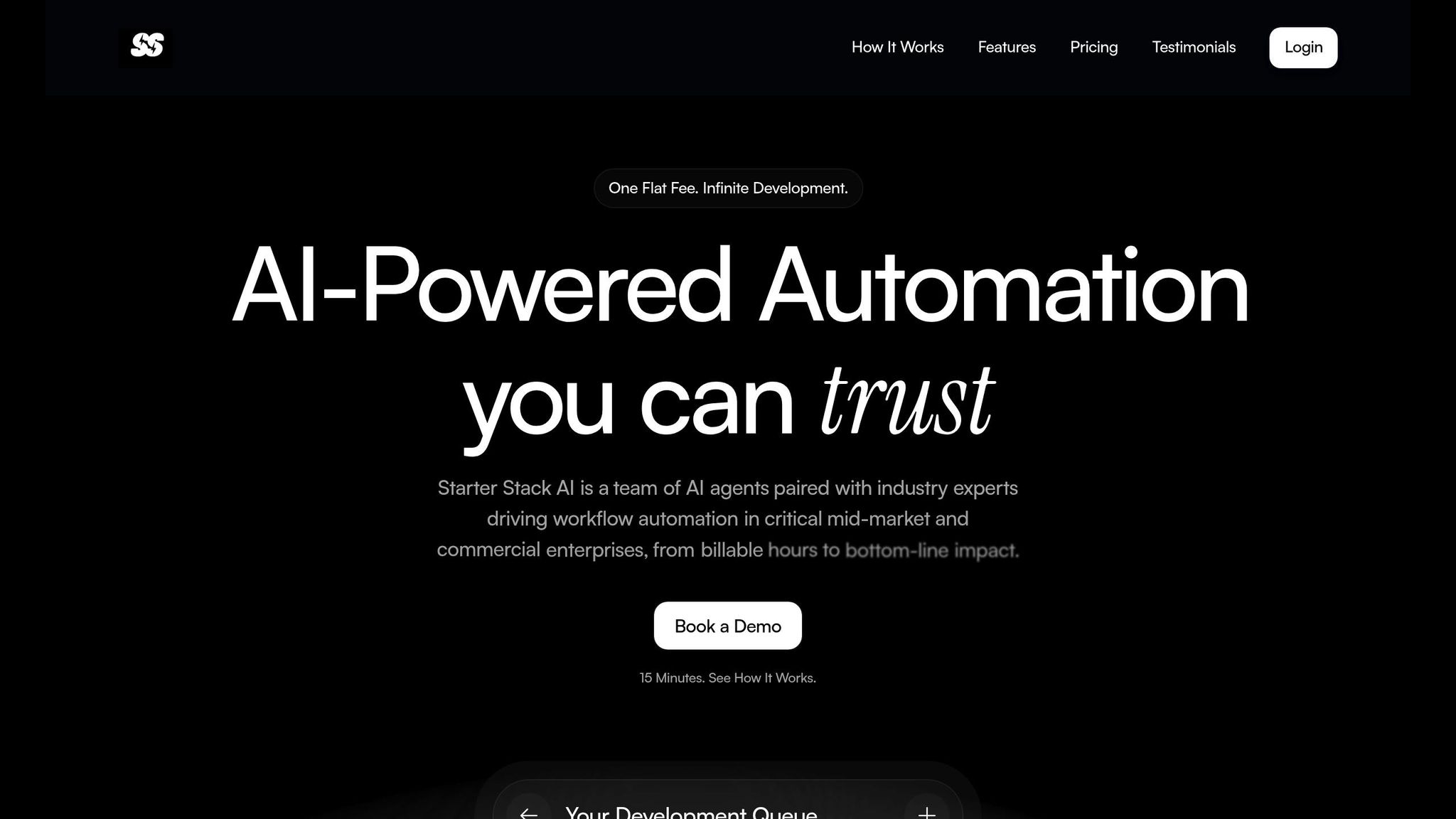How AI Improves Environment Consistency Validation
AI is transforming how businesses ensure software consistency across environments. By automating error detection, monitoring configurations, and managing compliance, AI tools reduce outages by up to 70% and cut operational costs by 31%. Key benefits include:
- Automated Monitoring: AI tracks and fixes configuration issues in real time.
- Compliance Management: Tools handle regulatory updates and flag risks early.
- Integration Across Systems: Works with cloud platforms, databases, and APIs.
- Cost Efficiency: Saves millions annually by reducing manual work and errors.
For example, Covered California used AI to increase document verification rates from 30% to 84%, with potential to exceed 95%. Businesses adopting AI for validation improve accuracy, save time, and maintain system reliability.
How to validate AI?
::: @iframe https://www.youtube.com/embed/O6uJGACIphI :::
1. Starter Stack AI Features

Starter Stack AI focuses on maintaining system consistency and meeting regulatory standards across enterprise operations by addressing four core areas.
Automated Environment Monitoring
With AI agents working around the clock, Starter Stack AI continuously monitors configurations and dependencies. These agents quickly identify any configuration changes or issues, ensuring smooth data flow by integrating seamlessly with popular cloud platforms like AWS and Azure [2][4].
Intelligent Compliance Management
The platform simplifies compliance by using AI to track regulatory requirements and validate system setups. Here's what it offers:
- Continuous real-time data collection and automated formatting
- Predictive analytics to flag potential compliance issues early
- Ongoing monitoring of system parameters
- Automated checks for security and compliance
This system ensures enterprises stay ahead of regulatory demands while maintaining smooth integration across platforms.
Advanced Integration Framework
Starter Stack AI connects effortlessly with essential enterprise systems, offering the following capabilities:
| Integration Type | Capabilities |
|---|---|
| Cloud Platforms | Direct links to AWS, Azure, and other leading cloud services |
| Database Systems | Built-in support for SQL Server and big data platforms |
| Business Tools | Easy integration with BI tools and data management platforms |
| Custom APIs | Compatibility with specialized enterprise systems |
Scalable Architecture
Designed to grow with your business, Starter Stack AI offers two scaling options. The Self-Managed plan supports up to 25,000 users or events per month, while the Managed plan handles up to 100,000 [1]. Standardized templates and AI-driven automation improve operational efficiency by as much as 20% [3].
Additionally, the platform prioritizes security, meeting strict data privacy regulations and ensuring robust API authentication [1].
2. Common AI Validation Tools
AI validation tools play a crucial role in ensuring consistency, accuracy, and compliance across enterprise environments. By automating monitoring and error detection, these tools help organizations maintain reliable systems while managing compliance more effectively.
Real-Time Monitoring and Error Detection
AI systems excel at spotting configuration drifts and inconsistencies in real time. For instance, these tools have been shown to reduce data processing errors by as much as 50% [8]. A notable example is Facebook (Meta), which uses AI-driven drift detection in its data centers to maintain high availability and ensure the reliability of its infrastructure [9].
Automated Compliance Management
AI validation tools streamline compliance processes by analyzing documents, monitoring risks, and keeping up with regulatory changes. Here's a breakdown of their capabilities:
| Capability | Function |
|---|---|
| Document Analysis | Reviews compliance documents automatically using natural language processing (NLP) |
| Risk Assessment | Monitors potential compliance risks in real time |
| Regulatory Tracking | Provides continuous updates on changing regulations |
| Data Privacy | Manages compliance with GDPR and HIPAA automatically |
By processing large datasets, machine learning models uncover critical information and assess risks to ensure organizations stay compliant [5].
Intelligent Data Validation
Walmart uses AI-driven configuration analysis to optimize its cloud resources and automate infrastructure management. This approach has led to significant reductions in operational costs [9]. These validation tools can seamlessly integrate across various systems, improving efficiency and accuracy.
Integration Capabilities
- Works with major cloud providers
- Supports a wide range of database systems
- Connects with custom enterprise platforms and third-party services
Cost Impact and Efficiency
The U.S. economy loses $3.1 trillion annually due to poor-quality data [8]. Effective validation tools can help organizations avoid these losses, improving operational efficiency and reducing compliance risks.
"The key is to enable AI testing and validation at a local level and allow ongoing monitoring at scale." – Seth Hain, Epic senior vice president of R&D [7]
Natural Language Processing
AI tools like Filevine's Validation AI simplify the validation process by allowing users to set criteria with natural language commands. For example, users can specify conditions like "Case notes must be present" or "Settlement amount must be greater than $10,000", making the process more intuitive and efficient [6].
sbb-itb-f5716fb
Benefits and Limitations
AI-powered validation tools bring both advantages and challenges, offering a mix of opportunities and hurdles based on industry data and practical use cases.
Benefits
Improved Accuracy and Detection
AI algorithms excel at spotting subtle configuration issues in cloud infrastructures. This capability allows for faster fixes and ensures systems stay consistent [12][13].
Real-Time Processing and Insights
With AI-driven tools, data is processed instantly, delivering immediate feedback on schema validation and structural changes [14].
| Performance Metric | Traditional Methods | AI-Powered Solutions | Impact |
|---|---|---|---|
| Processing Speed | Hours to days | Real-time to minutes | 60% faster processing [14] |
| Data Integration | Limited sources | Multiple sources | Broader and deeper coverage |
| Cost Efficiency | High ongoing costs | Lower long-term costs | Reduced operational expenses |
Limitations
High Initial Investment
Deploying AI validation tools requires significant upfront spending on hardware, software, and staff training. Organizations need to plan carefully to manage these initial costs.
Energy Usage
AI systems come with a heavy energy demand. By 2026, energy consumption from data centers, cryptocurrency, and AI could match Japan’s annual electricity usage [11].
Dependence on Data Quality
The performance of AI validation tools is only as good as the data they process. High-quality data collection and thorough preprocessing are essential for success.
These limitations are evident in various industries, where real-world applications showcase both the strengths and constraints of AI-powered validation.
Industry Applications
Enterprise Configuration Management
Large enterprises rely on AI systems to continuously validate infrastructure configurations, ensuring consistency across cloud environments [13].
Financial Services
In finance, AI-driven models simplify transaction validation and enhance the accuracy of regulatory reporting [14].
Cost vs. Benefit
AI-powered solutions provide long-term savings and efficiency by:
- Automated Monitoring: Reducing manual labor through continuous data analysis.
- Predictive Maintenance: Identifying issues early to prevent downtime.
- Scalable Architecture: Expanding across regions without proportionally increasing costs [10].
Summary and Recommendations
This section pulls together key strategies to make the most of AI-powered environment validation. By leveraging AI tools, organizations can achieve greater accuracy and efficiency, fundamentally improving how they maintain system consistency.
Establish Clear Metrics
Organizations that adopt AI validation tools report significant benefits, including a reduction in errors and an average cost savings of $12.9 million annually [4].
"An AI tool should be intuitive and user-friendly. Complexity should happen behind the scenes, allowing your team to integrate the tool into their existing workflows without requiring extensive training. Focus on tools with a clean interface and comprehensive, easy-to-understand documentation." [15]
Clear, measurable criteria like these lay the groundwork for successful AI adoption across operations.
Focus on Data Quality
Ensuring high-quality data is essential for effective AI validation. Here's how organizations can improve data quality and the outcomes they can expect:
| Component | Implementation Strategy | Expected Outcome |
|---|---|---|
| Data Governance | Define clear roles and standards | 30% reduction in quality issues |
| Quality Metrics | Use automated monitoring systems | 25% improvement in accuracy |
| Regular Audits | Conduct scheduled, thorough reviews | 20% increase in clinician trust [18] |
Investing in these areas helps organizations maintain reliable and accurate data, a cornerstone of successful AI initiatives.
Strategic Considerations
A solid strategy is just as important as implementation when it comes to long-term success.
Cost Analysis
"Evaluate the total cost of ownership, including maintenance, training, support, and any additional credits you might need - these can really rack up. Make sure that the ROI justifies the total investment." [15]
Balancing initial costs with long-term benefits ensures your investment in AI validation tools pays off over time.
Future-Proofing
As Gartner predicts, synthetic data will play a role in 75% of AI projects by 2026. Choosing validation tools that adapt to emerging trends while maintaining security and compliance is crucial [17].
Technical Integration
For a smooth implementation, consider tools that offer:
- API compatibility with your existing technology stack
- Clear and detailed documentation
- Strong vendor support for troubleshooting and updates
- Regular maintenance to keep systems optimized
Integrating AI validation tools effectively not only improves operational consistency but also supports broader goals like automation and streamlined workflows.
With the global AI market projected to hit $267 billion by 2027 [16], organizations that prioritize robust validation processes will be well-positioned to take advantage of this growing technological landscape.
FAQs
::: faq
How does AI help lower costs and prevent outages in maintaining consistent environments?
AI plays a key role in cutting costs and preventing disruptions by anticipating maintenance needs and automating routine tasks. Through machine learning, it examines data from sensors and system logs to detect potential problems before they escalate into unexpected breakdowns. This proactive approach lets businesses schedule maintenance during planned downtimes, reducing expensive interruptions and boosting overall productivity.
On top of that, AI-powered tools handle repetitive tasks like data validation, reducing the risk of human error and improving accuracy. By simplifying workflows, teams can dedicate more time to strategic initiatives, driving efficiency and maintaining smooth operations. These advantages translate into lower costs and increased reliability for businesses. :::
::: faq
What should businesses consider when investing in AI-powered tools for environment validation, and what ROI can they expect?
When considering AI-powered tools for environment validation, businesses need to weigh the initial investment, which can vary widely. Smaller projects might start at around $10,000, while large-scale implementations can climb into the millions. Beyond the upfront cost, companies should also account for ongoing expenses like maintenance, updates, and data management, typically amounting to 10–15% of the total project cost.
The potential return on investment (ROI) is impressive. Many businesses report an average ROI of 3.5 times their initial spending. These tools reduce errors, simplify workflows, and enhance efficiency, translating into significant cost savings and improved productivity. Over time, these advantages position AI as a powerful resource for maintaining stable environments and boosting overall profitability. :::
::: faq
How does Starter Stack AI comply with data privacy regulations like GDPR and HIPAA?
Starter Stack AI prioritizes data privacy by adhering to GDPR and HIPAA regulations through robust security measures. It employs AES-256 encryption to protect data both at rest and during transit, ensuring sensitive information stays secure. The platform's compliance with SOC 2 and HIPAA underscores its dedication to upholding strict privacy standards.
Beyond encryption, Starter Stack AI follows principles like data minimization and accountability. It only collects the information necessary for specific purposes and maintains clear communication with users about how their data is handled. These practices align with GDPR and HIPAA guidelines, ensuring personal information is managed responsibly and transparently. :::
